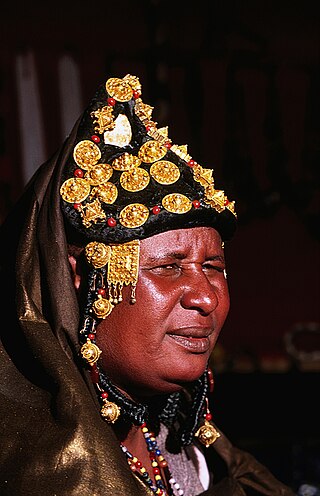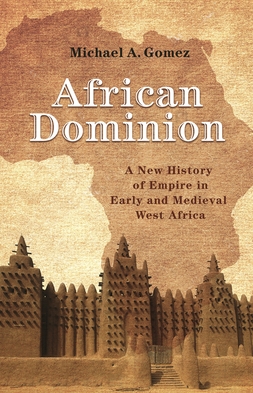Related Research Articles

The Songhai Empire was a state located in the western part of the Sahel during the 15th and 16th centuries. At its peak, it was one of the largest African empires in history. The state is known by its historiographical name, derived from its largest ethnic group and ruling elite, the Songhai people. Sonni Ali established Gao as the empire's capital, although a Songhai state had existed in and around Gao since the 11th century. Other important cities in the kingdom were Timbuktu and Djenné, where urban-centred trade flourished; they were conquered in 1468 and 1475, respectively. Initially, the Songhai Empire was ruled by the Sonni dynasty, but it was later replaced by the Askia dynasty (1493–1591).

The Songhai people are an ethnolinguistic group in West Africa who speak the various Songhai languages. Their history and lingua franca is linked to the Songhai Empire which dominated the western Sahel in the 15th and 16th century. Predominantly adherents of Islam, the Songhai are primarily located in Niger and Mali within the Western Sudanic region. Historically, the term "Songhai" did not denote an ethnic or linguistic identity but referred to the ruling caste of the Songhay Empire known as the Songhaiborai. However, the correct term used to refer to this group of people collectively by the natives is "Ayneha". Although some Speakers in Mali have also adopted the name Songhay as an ethnic designation, other Songhay-speaking groups identify themselves by other ethnic terms such as Zarma or Isawaghen. The dialect of Koyraboro Senni spoken in Gao is unintelligible to speakers of the Zarma dialect of Niger, according to at least one report. The Songhay languages are commonly taken to be Nilo-Saharan but this classification remains controversial: Dimmendaal (2008) believes that for now it is best considered an independent language family.

Askia Muhammad I (1443–1538), born Muhammad ibn Abi Bakr al-Turi or Muhammad Ture, was the first ruler of the Askia dynasty of the Songhai Empire, reigning from 1493 to 1528. He is also known as Askia the Great, and his name in modern Songhai is Mamar Kassey. Askia Muhammad strengthened his empire and made it the largest empire in West Africa's history. At its peak under his reign, the Songhai Empire encompassed the Hausa states as far as Kano and much of the territory that had belonged to the Songhai empire in the east. His policies resulted in a rapid expansion of trade with Europe and Asia, the creation of many schools, and the establishment of Islam as an integral part of the empire.
Sunni Ali, also known as Si Ali, Sunni Ali Ber, reigned from about 1464 to 1492 as the 15th ruler of the Sunni dynasty of the Songhai Empire. He transformed the relatively small state into an empire by conquering Timbuktu, Massina, the Inner Niger Delta, and Djenne.
Askia Ishaq II was the ruler of the Songhai Empire from 1588 to 1591. He was the son of Askia Daoud and a Zughrani concubine from the middle Niger region, and was also known as Askia Isḥāq Zughrānī.
Askia Mohammad Benkan, also Askiya Muhammad Bonkana Kirya, was the third ruler of the Songhai Empire from 1531 to 1537.
The Dendi was a former province of the Songhai Empire. It survived the fall of the Empire as a kingdom until 1901, when it was conquered by France and incorporated into French West Africa. Its centers today are the cities of Gaya in Niger, Kamba in Nigeria and Malanville in Benin.
Abū'l-Ḥasan Mu'nis al-Qushuri, also commonly known by the surnames al-Muẓaffar and al-Khadim, was the commander-in-chief of the Abbasid army from 908 to his death in 933 CE, and virtual dictator and king-maker of the Caliphate from 928 on.
Askia Musa or Askiya Musa was the second Askia ruler of the Songhai Empire.
Muhammad ibn Abd al-Karim al-Maghili, commonly known as Muhammad al-Maghili was a Berber 'alim from Tlemcen, the capital of the Kingdom of Tlemcen, now in modern-day Algeria. Al-Maghili was responsible for converting the ruling classes to Islam among Hausa, Fulani, and Tuareg peoples in West Africa.
The Askiya dynasty, also known as the Askia dynasty, ruled the Songhai Empire at the height of that state's power. It was founded in 1493 by Askia Mohammad I, a general of the Songhai Empire who usurped the Sonni dynasty. The Askiya ruled from Gao over the vast Songhai Empire until its defeat by a Moroccan invasion force in 1591. After the defeat, the dynasty moved south back to its homeland and created several smaller kingdoms in what is today Songhai in south-western Niger and further south in the Dendi.
Askia Ishaq I, also known as Ishaq Ber or Ishaq Kadibini, was the ruler of the Songhai Empire from 1539 to 1549, elected Askia following the death of Askia Isma'il. He was the fifth ruler of the Askiya dynasty.
Askia Ismail was the sixth ruler of the Songhai Empire from 1537 – 1539, and fourth from the Askia dynasty. He was the son of Askia Mohammad I, the founder of the Askia dynasty, and Maryam Daabu, a member of the Malian royal family captured in 1501.
Kabara is a small town in Mali on the Niger River, the port for Timbuktu. It is 8 km (5 mi) to the south of Timbuktu and is connected to an arm of the Niger River by a 3 km (2 mi) canal. The town has at times in the past been linked to Timbuktu by an extension of the canal. However, silting and lower water levels in recent years have made the extension canal unusable and the Kabara port usable only during the high water seasons.
Askia Daoud was the ruler of the Songhai Empire from 1549 to 1582. His rule saw the empire rise to a peak of peace and prosperity following a series of succession disputes and short reigns.
Muhammad Dan Abdullahi, known as Muhammad Kisoki, was the Sultan of Kano from 1509 until his death in 1565. His 56-year reign is the longest of the state's Rumfawa era.
The Moroccan invasion of the Songhai Empire began with an expedition sent in 1590 by Sultan Ahmad al-Mansur of the Saadian dynasty, which ruled over Morocco at the time. The Saadian army, led by Judar Pasha, arrived in the Niger valley region in 1591 and won its first and most decisive victory against the forces of Askia Ishaq II at the Battle of Tondibi and occupied the capital of Gao shortly after.

African Dominion: A New History of Empire in Early and Medieval West Africa, by Michael A. Gomez, focuses on the regions surrounding the Middle Niger Valley. It can be thought of as tracing the rise and fall of empire as a form of local political organization in West Africa, culminating in the Songhay Empire; thus it primarily covers the millennium from the mid-sixth century to 1591 CE, when Songhay came under Moroccan rule. It has been particularly noted for using a wide range of non-European sources, particularly Arabic-language material, to develop a non-Eurocentric account of medieval West African history.
Askia Muhammad al-Hajj was the ruler of the Songhai Empire from 1582 to 1586.
Askia Muhammad Gao was the last ruler of the Songhai Empire, son of Askia Daud. He assumed power in the last months of 1591 after the defeat of Askia Ishaq II by Moroccan forces. Yet in the same year, about forty days after taking power, he was lured into a trap and killed by the Moroccans.
References
- 1 2 Levtzion, Nehemiah (1977). "5 - The western Maghrib and Sudan". In Oliver, Ronald (ed.). The Cambridge History of Africa Volume 3: From c.1050 to c.1600. Cambridge University Press. p. 439-440. ISBN 9781139054577 . Retrieved 12 March 2024.
- 1 2 3 4 Gomez, Michael (2018). African dominion : a new history of empire in early and medieval West Africa. Princeton, NJ: Princeton University Press. ISBN 9780691177427.